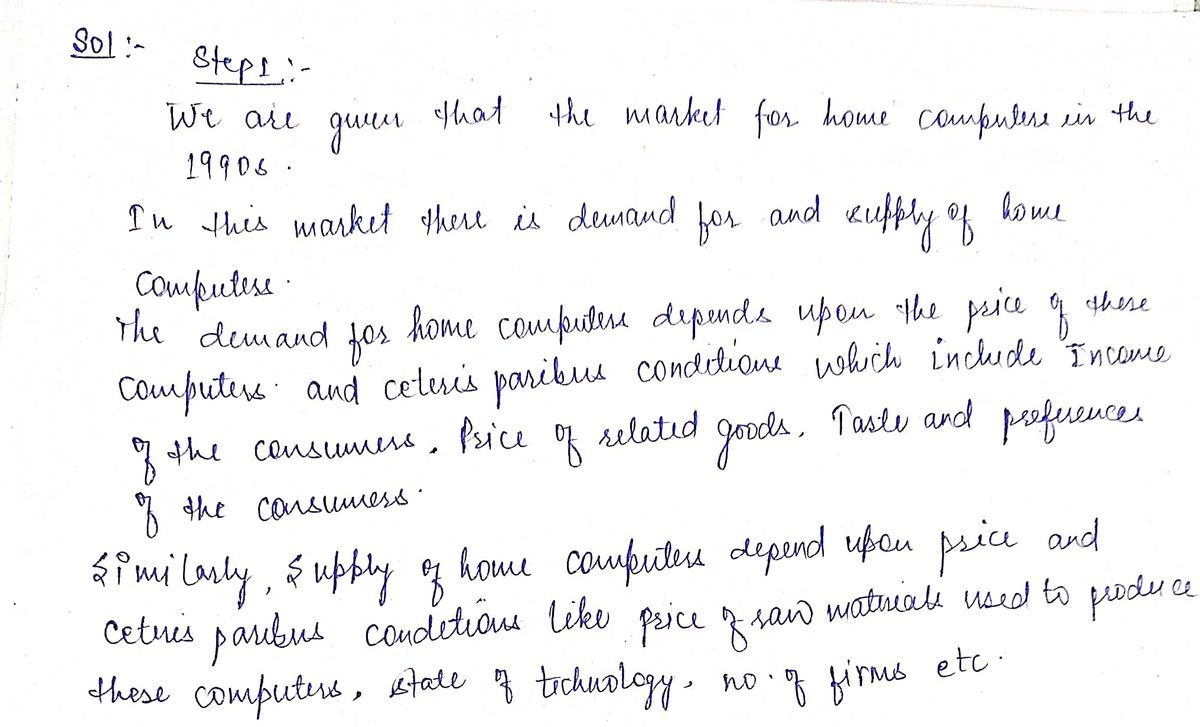Imagine the market for home computers in the 1990s. a. Start in Equilibrium (be sure to label all relevant points) b. Change at least one of the ceteris paribus conditions. As the internet begins to provide entertainment and commerce options in a graphical format that everyone can understand, improvements in processor technology also arrive. c. Examine the changed incentive. Which curve(s) has(have) changed? Why? (i.e. – which of the ceteris paribus conditions have changed?) _______________________________________________________ d. Identify the change(s) in direction, and draw into the above market. e. Finish in equilibrium. What are the effects on price and quantity?
Imagine the market for home computers in the 1990s. a. Start in Equilibrium (be sure to label all relevant points) b. Change at least one of the ceteris paribus conditions. As the internet begins to provide entertainment and commerce options in a graphical format that everyone can understand, improvements in processor technology also arrive. c. Examine the changed incentive. Which curve(s) has(have) changed? Why? (i.e. – which of the ceteris paribus conditions have changed?) _______________________________________________________ d. Identify the change(s) in direction, and draw into the above market. e. Finish in equilibrium. What are the effects on price and quantity?
Chapter1: Making Economics Decisions
Section: Chapter Questions
Problem 1QTC
Related questions
Question
8. Imagine the market for home computers in the 1990s.
a. Start in Equilibrium (be sure to label all relevant points)
b. Change at least one of the ceteris paribus conditions. As the internet begins to provide entertainment and commerce options in a graphical format that everyone can understand, improvements in processor technology also arrive.
c. Examine the changed incentive. Which curve(s) has(have) changed? Why? (i.e. – which of the ceteris paribus conditions have changed?) _______________________________________________________
d. Identify the change(s) in direction, and draw into the above market.
e. Finish in equilibrium. What are the effects on price and quantity?
Expert Solution
Step 1

Trending now
This is a popular solution!
Step by step
Solved in 3 steps with 3 images

Knowledge Booster
Learn more about
Need a deep-dive on the concept behind this application? Look no further. Learn more about this topic, economics and related others by exploring similar questions and additional content below.Recommended textbooks for you


Principles of Economics (12th Edition)
Economics
ISBN:
9780134078779
Author:
Karl E. Case, Ray C. Fair, Sharon E. Oster
Publisher:
PEARSON

Engineering Economy (17th Edition)
Economics
ISBN:
9780134870069
Author:
William G. Sullivan, Elin M. Wicks, C. Patrick Koelling
Publisher:
PEARSON


Principles of Economics (12th Edition)
Economics
ISBN:
9780134078779
Author:
Karl E. Case, Ray C. Fair, Sharon E. Oster
Publisher:
PEARSON

Engineering Economy (17th Edition)
Economics
ISBN:
9780134870069
Author:
William G. Sullivan, Elin M. Wicks, C. Patrick Koelling
Publisher:
PEARSON

Principles of Economics (MindTap Course List)
Economics
ISBN:
9781305585126
Author:
N. Gregory Mankiw
Publisher:
Cengage Learning

Managerial Economics: A Problem Solving Approach
Economics
ISBN:
9781337106665
Author:
Luke M. Froeb, Brian T. McCann, Michael R. Ward, Mike Shor
Publisher:
Cengage Learning

Managerial Economics & Business Strategy (Mcgraw-…
Economics
ISBN:
9781259290619
Author:
Michael Baye, Jeff Prince
Publisher:
McGraw-Hill Education